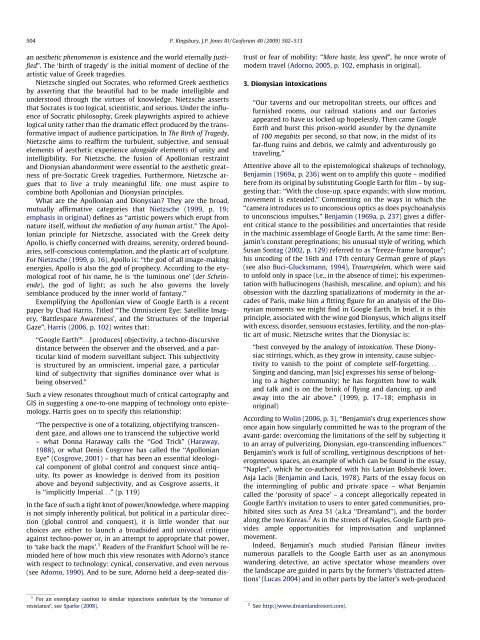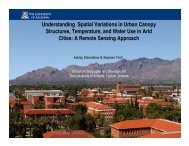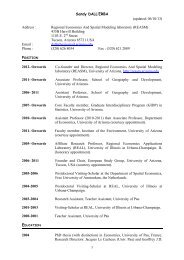Walter Benjamin's Dionysian Adventures on Google Earth
Walter Benjamin's Dionysian Adventures on Google Earth
Walter Benjamin's Dionysian Adventures on Google Earth
Create successful ePaper yourself
Turn your PDF publications into a flip-book with our unique Google optimized e-Paper software.
504 P. Kingsbury, J.P. J<strong>on</strong>es III / Geoforum 40 (2009) 502–513an aesthetic phenomen<strong>on</strong> is existence and the world eternally justified”.The ‘birth of tragedy’ is the initial moment of decline of theartistic value of Greek tragedies.Nietzsche singled out Socrates, who reformed Greek aestheticsby asserting that the beautiful had to be made intelligible andunderstood through the virtues of knowledge. Nietzsche assertsthat Socrates is too logical, scientistic, and serious. Under the influenceof Socratic philosophy, Greek playwrights aspired to achievelogical unity rather than the dramatic effect produced by the transformativeimpact of audience participati<strong>on</strong>. In The Birth of Tragedy,Nietzsche aims to reaffirm the turbulent, subjective, and sensualelements of aesthetic experience al<strong>on</strong>gside elements of unity andintelligibility. For Nietzsche, the fusi<strong>on</strong> of Apoll<strong>on</strong>ian restraintand <str<strong>on</strong>g>Di<strong>on</strong>ysian</str<strong>on</strong>g> aband<strong>on</strong>ment were essential to the aesthetic greatnessof pre-Socratic Greek tragedies. Furthermore, Nietzsche arguesthat to live a truly meaningful life, <strong>on</strong>e must aspire tocombine both Apoll<strong>on</strong>ian and <str<strong>on</strong>g>Di<strong>on</strong>ysian</str<strong>on</strong>g> principles.What are the Apoll<strong>on</strong>ian and <str<strong>on</strong>g>Di<strong>on</strong>ysian</str<strong>on</strong>g>? They are the broad,mutually affirmative categories that Nietzsche (1999, p. 19;emphasis in original) defines as ‘‘artistic powers which erupt fromnature itself, without the mediati<strong>on</strong> of any human artist.” The Apoll<strong>on</strong>ianprinciple for Nietzsche, associated with the Greek deityApollo, is chiefly c<strong>on</strong>cerned with dreams, serenity, ordered boundaries,self-c<strong>on</strong>scious c<strong>on</strong>templati<strong>on</strong>, and the plastic art of sculpture.For Nietzsche (1999, p. 16), Apollo is: ‘‘the god of all image-makingenergies, Apollo is also the god of prophecy. According to the etymologicalroot of his name, he is ‘the luminous <strong>on</strong>e’ (der Scheinende),the god of light; as such he also governs the lovelysemblance produced by the inner world of fantasy.”Exemplifying the Apoll<strong>on</strong>ian view of <strong>Google</strong> <strong>Earth</strong> is a recentpaper by Chad Harris. Titled ‘‘The Omniscient Eye: Satellite Imagery,‘Battlespace Awareness’, and the Structures of the ImperialGaze”, Harris (2006, p. 102) writes that:‘‘<strong>Google</strong> <strong>Earth</strong> TM ...[produces] objectivity, a techno-discursivedistance between the observer and the observed, and a particularkind of modern surveillant subject. This subjectivityis structured by an omniscient, imperial gaze, a particularkind of subjectivity that signifies dominance over what isbeing observed.”Such a view res<strong>on</strong>ates throughout much of critical cartography andGIS in suggesting a <strong>on</strong>e-to-<strong>on</strong>e mapping of technology <strong>on</strong>to epistemology.Harris goes <strong>on</strong> to specify this relati<strong>on</strong>ship:‘‘The perspective is <strong>on</strong>e of a totalizing, objectifying transcendentgaze, and allows <strong>on</strong>e to transcend the subjective world– what D<strong>on</strong>na Haraway calls the ‘‘God Trick” (Haraway,1988), or what Denis Cosgrove has called the ‘‘Apoll<strong>on</strong>ianEye” (Cosgrove, 2001) – that has been an essential ideologicalcomp<strong>on</strong>ent of global c<strong>on</strong>trol and c<strong>on</strong>quest since antiquity.Its power as knowledge is derived from its positi<strong>on</strong>above and bey<strong>on</strong>d subjectivity, and as Cosgrove asserts, itis ‘‘implicitly Imperial...” (p. 119)In the face of such a tight knot of power/knowledge, where mappingis not simply inherently political, but political in a particular directi<strong>on</strong>(global c<strong>on</strong>trol and c<strong>on</strong>quest), it is little w<strong>on</strong>der that ourchoices are either to launch a broadsided and univocal critiqueagainst techno-power or, in an attempt to appropriate that power,to ‘take back the maps’. 1 Readers of the Frankfurt School will be remindedhere of how much this view res<strong>on</strong>ates with Adorno’s stancewith respect to technology: cynical, c<strong>on</strong>servative, and even nervous(see Adorno, 1990). And to be sure, Adorno held a deep-seated distrustor fear of mobility: ‘‘More haste, less speed”, he <strong>on</strong>ce wrote ofmodern travel (Adorno, 2005, p. 102, emphasis in original).3. <str<strong>on</strong>g>Di<strong>on</strong>ysian</str<strong>on</strong>g> intoxicati<strong>on</strong>s‘‘Our taverns and our metropolitan streets, our offices andfurnished rooms, our railroad stati<strong>on</strong>s and our factoriesappeared to have us locked up hopelessly. Then came <strong>Google</strong><strong>Earth</strong> and burst this pris<strong>on</strong>-world asunder by the dynamiteof 100 megabits per sec<strong>on</strong>d, so that now, in the midst of itsfar-flung ruins and debris, we calmly and adventurously gotraveling.”Attentive above all to the epistemological shakeups of technology,Benjamin (1969a, p. 236) went <strong>on</strong> to amplify this quote – modifiedhere from its original by substituting <strong>Google</strong> <strong>Earth</strong> for film – by suggestingthat: ‘‘With the close-up, space expands; with slow moti<strong>on</strong>,movement is extended.” Commenting <strong>on</strong> the ways in which the‘‘camera introduces us to unc<strong>on</strong>scious optics as does psychoanalysisto unc<strong>on</strong>scious impulses,” Benjamin (1969a, p. 237) gives a differentcritical stance to the possibilities and uncertainties that residein the machinic assemblage of <strong>Google</strong> <strong>Earth</strong>. At the same time: Benjamin’sc<strong>on</strong>stant peregrinati<strong>on</strong>s; his unusual style of writing, whichSusan S<strong>on</strong>tag (2002, p. 129) referred to as ‘‘freeze-frame baroque”;his uncoding of the 16th and 17th century German genre of plays(see also Buci-Glucksmann, 1994), Trauerspielen, which were saidto unfold <strong>on</strong>ly in space (i.e., in the absence of time); his experimentati<strong>on</strong>with hallucinogens (hashish, mescaline, and opium); and hisobsessi<strong>on</strong> with the dazzling spatializati<strong>on</strong>s of modernity in the arcadesof Paris, make him a fitting figure for an analysis of the <str<strong>on</strong>g>Di<strong>on</strong>ysian</str<strong>on</strong>g>moments we might find in <strong>Google</strong> <strong>Earth</strong>. In brief, it is thisprinciple, associated with the wine god Di<strong>on</strong>ysus, which aligns itselfwith excess, disorder, sensuous ecstasies, fertility, and the n<strong>on</strong>-plasticart of music. Nietzsche writes that the Di<strong>on</strong>ysiac is:‘‘best c<strong>on</strong>veyed by the analogy of intoxicati<strong>on</strong>. These Di<strong>on</strong>ysiacstirrings, which, as they grow in intensity, cause subjectivityto vanish to the point of complete self-forgetting...Singing and dancing, man [sic] expresses his sense of bel<strong>on</strong>gingto a higher community; he has forgotten how to walkand talk and is <strong>on</strong> the brink of flying and dancing, up andaway into the air above.” (1999, p. 17–18; emphasis inoriginal)According to Wolin (2006, p. 3), ‘‘Benjamin’s drug experiences show<strong>on</strong>ce again how singularly committed he was to the program of theavant-garde: overcoming the limitati<strong>on</strong>s of the self by subjecting itto an array of pulverizing, <str<strong>on</strong>g>Di<strong>on</strong>ysian</str<strong>on</strong>g>, ego-transcending influences.”Benjamin’s work is full of scrolling, vertiginous descripti<strong>on</strong>s of heterogeneousspaces, an example of which can be found in the essay,‘‘Naples”, which he co-authored with his Latvian Bolshevik lover,Asja Lacis (Benjamin and Lacis, 1978). Parts of the essay focus <strong>on</strong>the intermingling of public and private space – what Benjamincalled the ‘porosity of space’ – a c<strong>on</strong>cept allegorically repeated in<strong>Google</strong> <strong>Earth</strong>’s invitati<strong>on</strong> to users to enter gated communities, prohibitedsites such as Area 51 (a.k.a ‘‘Dreamland”), and the borderal<strong>on</strong>g the two Koreas. 2 As in the streets of Naples, <strong>Google</strong> <strong>Earth</strong> providesample opportunities for improvisati<strong>on</strong> and unplannedmovement.Indeed, Benjamin’s much studied Parisian flâneur invitesnumerous parallels to the <strong>Google</strong> <strong>Earth</strong> user as an an<strong>on</strong>ymouswandering detective, an active spectator whose meanders overthe landscape are guided in parts by the former’s ‘distracted attenti<strong>on</strong>s’(Lucas 2004) and in other parts by the latter’s web-produced1 For an exemplary cauti<strong>on</strong> to similar injuncti<strong>on</strong>s underlain by the ‘romance ofresistance’, see Sparke (2008).2 See http://www.dreamlandresort.com/.




